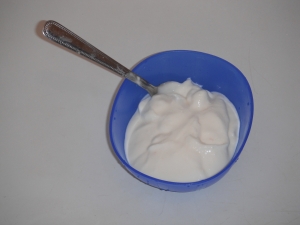I have been making yogurt (on and off) since September 2011. I have read a whole bunch of recipes and, through much trial and error, found a recipe that works for my family. Some things that I have learned about how to make yogurt are as follows:
1. The longer you let the yogurt ferment, the more tart it becomes. My family does not like tart yogurt so about 4-5 hours results in a milder taste.
2. If the milk boils over you can clean up the mess while it cools down and the remaining milk will still work for yogurt.
3. A thermometer is handy to have but not essential.
4. White/clear vanilla tastes much better than the dark stuff.
I will tell you my method but you may need to tweak it a bit for your family’s taste preference.
Materials required:
- Container(s) for finished yogurt with a secure lid (glass or plastic works)
- Enough milk to fill your container(s)
- Pot with a lid that will fit the milk
- Thermometer (handy but optional)
- Yogurt starter or some store-bought yogurt with live, active bacterial cultures (doesn’t really matter which brand, I have had success with several kinds, it is handy if it is plain or vanilla because otherwise you end up with a couple chunks of fruit in your yogurt)
- For greek yogurt: fabric to strain through (I have used cotton flat diapers and flannel receiving blankets), colander, and a pot that fits the colander if you want to save the whey
Steps:
- Put milk into pot.
- Heat the milk until almost boiling (about 180F). It will reach this temperature much faster if you use a lid.
- Simmer at this temperature for about 1-2 hours (with a lid so it doesn’t lose heat)
- Remove from heat. At this point you can put it into a sink full of cold water to speed cooling or just let it sit on your counter to cool. It is ready when it is about the same temp as a warm (not hot) bath (about 110F). If it is too hot your starter bacteria will die. (I tried to think of another way to word that but “get killed” sounded just as drastic)
- Have about a tablespoon of starter yogurt per liter of milk. Put them in a separate small bowl and add a few tablespoons of milk. Mix well. It is easier to mix into a large milk amount when it is diluted a bit with the milk already.
- Pour milk-diluted starter into your milk and mix well. At this point you can also add some vanilla or other extract. (Some recipes say you can add sugar/sweetener at this point but I have never had luck with that.)
- Pour into your yogurt container(s).
- Wrap in a blanket and/or put in a warm place where it will not get disturbed while it ferments. I usually turn my oven on for a bit (until it reaches about 100F) and then turn it off, wrap my yogurt in a blanket and put it in the oven. I have also put it in the bathtub wrapped in a blanket but that piqued my sons’ curiosity a little too much. In the oven it is out of their sight.
- Let it sit, undisturbed, for about 4-5 hours.
- Put it in the fridge overnight and by morning you will have yogurt!
Greek yogurt:
- The next morning pour/dump your yogurt into the colander lined with the fabric
- Put it in the fridge and let the whey drip out. I usually leave it for about 3 hours for 7 cups of yogurt.
- Put it back in the container (or in a different one if you prefer).
Note: For 7 cups of yogurt I end up with about 2 -3 cups of Greek yogurt. And you can use the whey for numerous things, though I still haven’t figured out what to use mine for.
So there you have it. Here is the short version: Heat milk, cool milk, add starter, let it sit in warmth, overnight it in the fridge and enjoy!
I usually start my yogurt at about 2pm (while my littlest is napping) and heat till around 4. Then it ferments until about 9 and I stick it in the fridge overnight. I set my oven timer and have even put reminders on my phone because otherwise I forget about it.
Have you ever made yogurt? I’d love to hear your yogurt making stories!
Do you have any other tips/tricks to share?
Do you have any other tips/tricks to share?







Whey is gold! It’s a great pick me up and thirst quencher. Whey with a squeeze of lemon in water is very refreshing. It’s a bit tart and. At take a bit to get used to but along with cutting out sugar and this- my taste buds have changed and I don’t crave sugar now. Another one to look into is kefir. Both really healthy good stuff. Enjoy.
I may havet o give that a shot. Thanks for the suggestion!
Reblogged this on HomesteadHacker and commented:
YUMMY